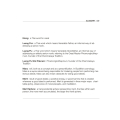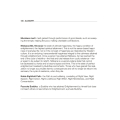terms : ค้นหาหนังสือธรรมะ หน้า 1 / 7
หน้าหนังสือทั้งหมด

55
Implications of Dhamma and Brahma in Buddhist Teachings
…68 or where 'brahmacariyā' and 'dhammacariyā' appear to correspond.69 The parallel usage of the two terms appears to have some significance. On their own, both terms can carry different connotations in dif…
เนื้อหานี้สำรวจการใช้คำว่า 'ดัมมะ' และ 'บราเหมะ' ในวรรณกรรมพุทธศาสนา และการตีความความหมายที่เชื่อมโยงกันของทั้งสองคำ เป็นการศึกษาความสำคัญของการใช้คำที่ขนานกัน ซึ่งสะท้อนถึงสถานะความบริสุทธิ์สูงสุดที่

57
The Concept of Dhamma and Kāya in Buddhist Philosophy
On the whole, it appears that the terms dhamma and brahma constituting four designations of the Tathāgāta are used in the sense of the ‘hig…
This study examines the terms dhamma and brahma, suggesting that they refer to the highest aspect of Tathāgāta, likely Nibbāna. T…

58
Understanding the Concept of Body and Collection in Dhamma
Functionally, however, both terms seem to imply a different relationship between individual members and the ‘totality’ of the whole ‘…
This text analyzes the distinctions between the terms 'body' and 'collection' within the framework of Dhamma, particularly focusing on functional depende…

76
Understanding the Terms Kevala and Dhammakāya in Buddhist Texts
…ver, the ambiguous structure of the verse allows some space for alternative translations. Here, the terms dhammakāya and ratanākara, as well as the present participle dipenta, are written in the same case,…
This text explores the interpretation of key Buddhist terms such as 'kevala', which denotes 'only' or 'entirely', particularly in contexts associated with illu…

131
Eastern Han Buddhist Meditation and Daoism
…義 “method of analogy”, which Mair calls “matching concepts” or “matching meanings,” and used Daoist terms to explain Buddhist concepts.55 For example, An Shigao borrowed the Daoist term for meditation shou…
… for meditation, representing concentration efforts. Throughout the Eastern Han Period (25-220 CE), terms like 'si' and 'cun' were adopted to describe Buddhist meditative practices. This strategic use of D…

52
Glossary of Key Buddhist Terms
1. Arahant
Glossary
An enlightened being who is free from defilements
and no longer subjected to rebirths or has attained
Nibbana.
2. Bodhisatta
One who determines to be a Buddha in the future.
3. Dha
This glossary provides definitions of key terms in Buddhism, including Arahant, an enlightened being who has attained Nibbana, Bodhisatta, a future…

24
Dhamma for Laypersons: Cultivating Good Habits
…. Habit of Responsibility - Whatever the task at hand,
he must do it to the best of his ability, in terms of quality,
time, budget, and caring for the quality of mind.
2. Habit of self-training and self-im…
บุคคลที่มีธรรมสำหรับอุบาสกอุบาสิกาต้องแสดงถึงนิสัยประจำสี่ประการ ได้แก่ นิสัยความรับผิดชอบ, การฝึกฝนและพัฒนาตนเอง, ความอดทน, และการเสียสละและการให้ นิสัยเหล่านี้ช่วยทำให้กลายเป็นผู้นำครอบครัวที่ดี การ

7
Understanding the Mind in Thai Culture
…discussed here can be put under the scope of
science and, thus, we have to use original, scientific terms
to contextually describe them, as the Pali Sanskrit language
specifically and exactly defines the p…
… in Thai culture and the rich linguistic resources that explain human cognition. It emphasizes that terms often linked to Buddhism should be treated as vocabulary, not dogma, and that teachings on the mind…

8
Understanding Boonya and Kilesa in Buddhist Teachings
…adjusting of the seasoning to help others see them in their
true light.
Two important Pali Sanskrit terms that are discussed
in this book are boonya and kilesa. Both of these concepts
may be difficult for …
This text delves into the Pali Sanskrit terms Boonya and Kilesa, emphasizing their importance in Buddhist teachings. Boonya, described as self-ge…

4
The Path to Dhamma: Understanding Dhammakaya Meditation
…QUE ⚫ 37
MAINTAINING MEDITATION IN EVERYDAY LIFE⚫ 57
ELEMENTS OF BUDDHIST LIFESTYLE⚫ 67
Glossary of terms
82
84
Basic Dhammakaya Meditation
About the Author⚫ 91
Contributors • 94
Lists of Meditation Centre…
…d elements that affirm the impact of Dhamma in our lives. This resource also includes a glossary of terms for better understanding, as well as a list of meditation centers worldwide for further exploration…

7
Wisdom of Luang Phaw: Sayings on Meditation and Life
…aw Dhammajayo's teachings are firmly rooted in
Buddhist culture, he makes use of several specialist terms which have
been left unexplained in the text but for which readers are referred
to a glossary of se…
… to enhance their everyday lives. While the content is rooted in Buddhist culture, some specialized terms are included without explanations, directing readers to a glossary at the end of the book. The sayi…

206
ปรมฤทธฺญายานาม วิฑ ฐิติสมฺมงคล
…ated to powers, virtues, and spiritual substance within a Buddhist or spiritual context, mentioning terms such as "power," "virtue," "mind," and related philosophical or spiritual terms.
ข้อความนี้เป็นการตีความหรือการคัดเลือกในภาษาสันสกฤตที่เขียนในสคริปต์ไทย โดยมีเนื้อหาเกี่ยวกับแนวคิดในการอภิปรายถึงพลัง คุณธรรม และสาระของจิตวิญญาณภายในบริบททางพุทธศาสนา อีกทั้งยังกล่าวถึงคำศัพท์ที่เกี

24
Dhamma for Laypersons and the Four Levels of Beauty
…. Habit of Responsibility – Whatever the task at hand, he must do it to the best of his ability, in terms of quality, time, budget, and caring for the quality of mind.
2. Habit of self-training and self-i…
A person who follows the Dhamma for Laypersons exhibits four habits: responsibility, self-training, endurance, and sacrifice. These traits ensure self-reliance and leadership within families. In marri

34
Understanding Dhammakāya in Early Buddhist Thought
…equently mentioned is located in the Aggāṇa-sutta where the term dhammakāya, along with three other terms, are said to designate the Tathāgata. The second is a passage in the Mahāparinibbāna-sutta where th…
The term 'dhammakāya' in the Pali canon is understood as representing the Buddha's teachings. It is established through several canonical passages that equate the Buddha with dhamma. Notable reference

41
Understanding Dhammakāya: A Scholarly Interpretation
…ication of parallel descriptions between monks and brahmins
3. implication of parallel usage of the terms dhamma and brahma
The following section will assess these points more closely. It will then determi…
…rion of saddhā as the Tathāgata's son, the parallels between monks and brahmins, and the use of the terms dhamma and brahma. The discussion references a key passage illustrating the dual meanings of dhamma…

56
Understanding Brahmabhūta and the Path to Nibbāna
… together, both are said to be the highest ways of living.
It is likely that the analogue of both terms in ‘dhammakāya,’ ‘brahmakāya,’ ‘dhamma bhūta’ and ‘brahma bhūta’ in the Agañña-sutta can be underst…
…rallels 'dhammacarĺa' and 'brahmacarĺa' as the highest ways of living. The connection between these terms and the concept of Nibbāna is explored, with the idea of 'brahma' representing the undying state so…

124
Meditation Practices Introduced by An Shigao in Eastern Han China
…ost); the Renben yusheng jing (T14). These texts all contain classified and sub-classified lists of terms and concepts of chan shu. According to Mair (2010) the term chanshu, which occurs in Dao’an’s prefa…
…ing and the Daodi jing, focus on this meditation style. They provide structured lists of meditation terms, emphasizing the importance of mindfulness in breath counting. Mair (2010) notes that the term 'cha…

133
The Practice of Neidan: Achieving Longevity and Immortality
… (lianqi huashen 煉氣化神), (4) Refining Spirit and Reverting to Emptiness (lianshen huanxu 煉神化虛).69 In terms of meditation and inner alchemy there are three cinnabar fields; one of them is tan-t’ian/ dantian,…
…and the Profound Merging to facilitate the journey towards immortality. An Shigao’s usage of Daoist terms illustrates the Chinese interpretation of Nirvāṇa. Key stages include Laying the Foundations, Refin…

161
Understanding Key Thai Terms in Buddhism
Klong: a Thai word for canal
Luang Por: a Thai word which means Venerable Father, an informal way of addressing a senior monk.
Luang Pu: a Thai word which means Venerable Grandfather, an informal wa
This text provides insight into important Thai terms associated with Buddhism. Terms such as 'Klong' refer to canals, while 'Luang Por' and 'Luang Pu' a…

162
Glossary of Buddhist Terms
158 GLOSSARY
Mundane merit: merit gained through performance of good deeds, such as sweeping the temple, helping the poor, making charitable contributions.
Nibbana (Skt. Nirvana): the state of ultim
This glossary provides definitions and insights into crucial Buddhist terms such as Mundane Merit, which refers to merit from good deeds, and Nibbana, the ultimate state of ha…
